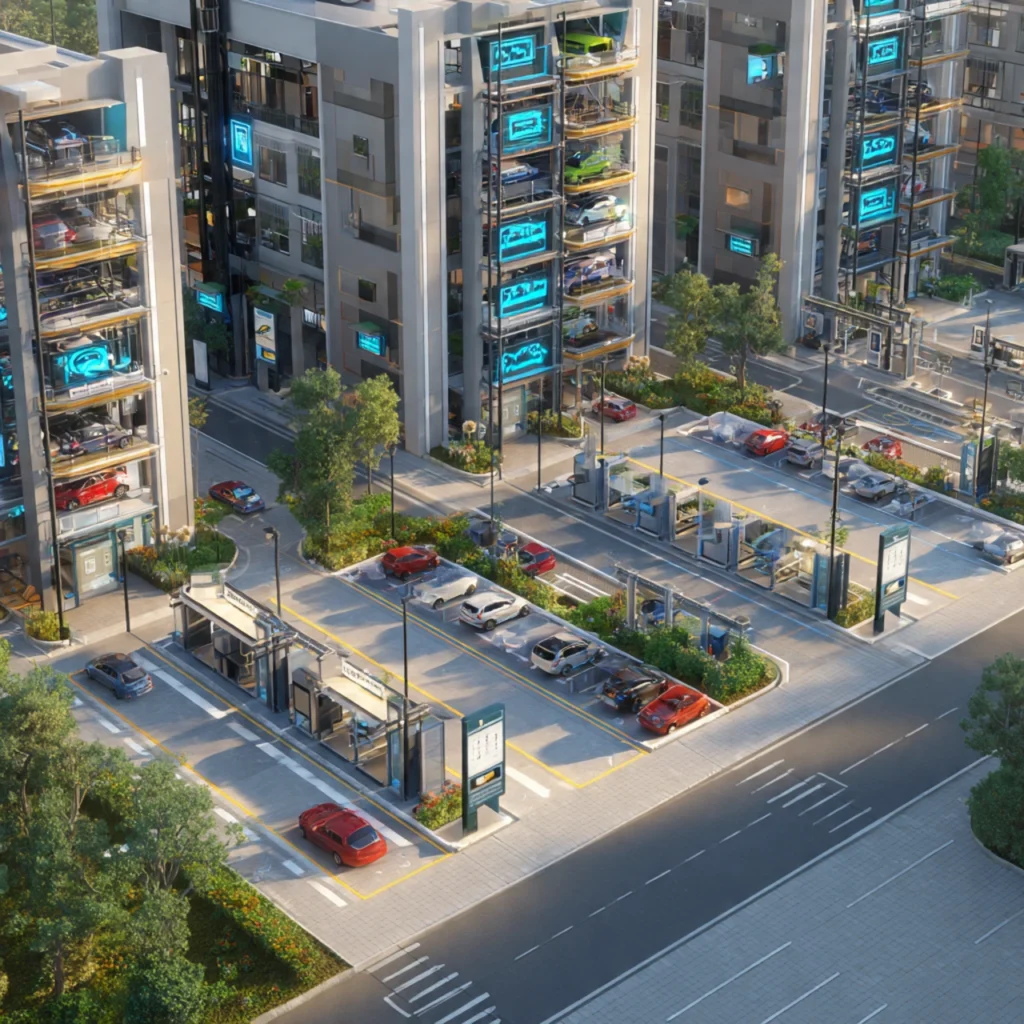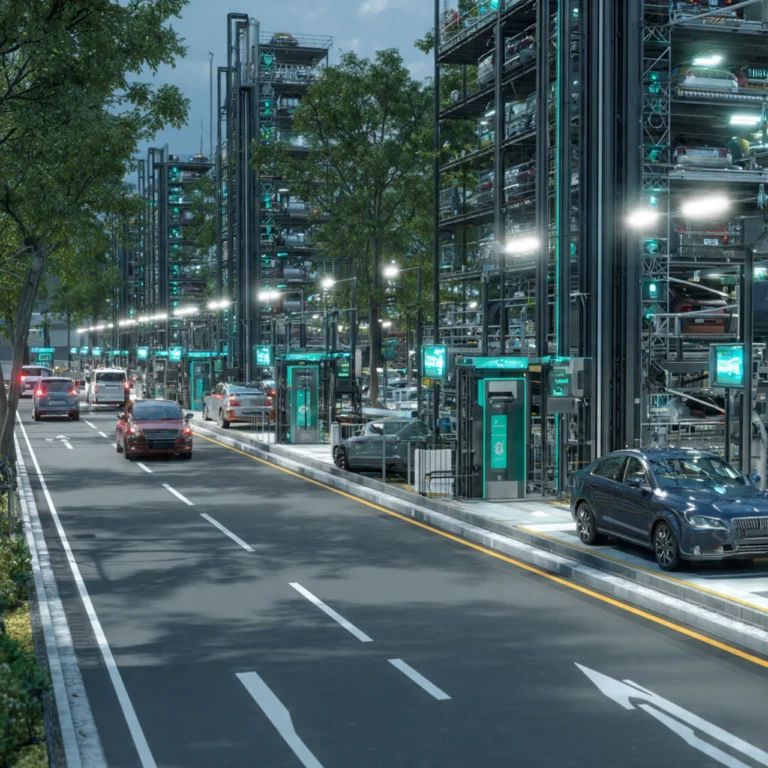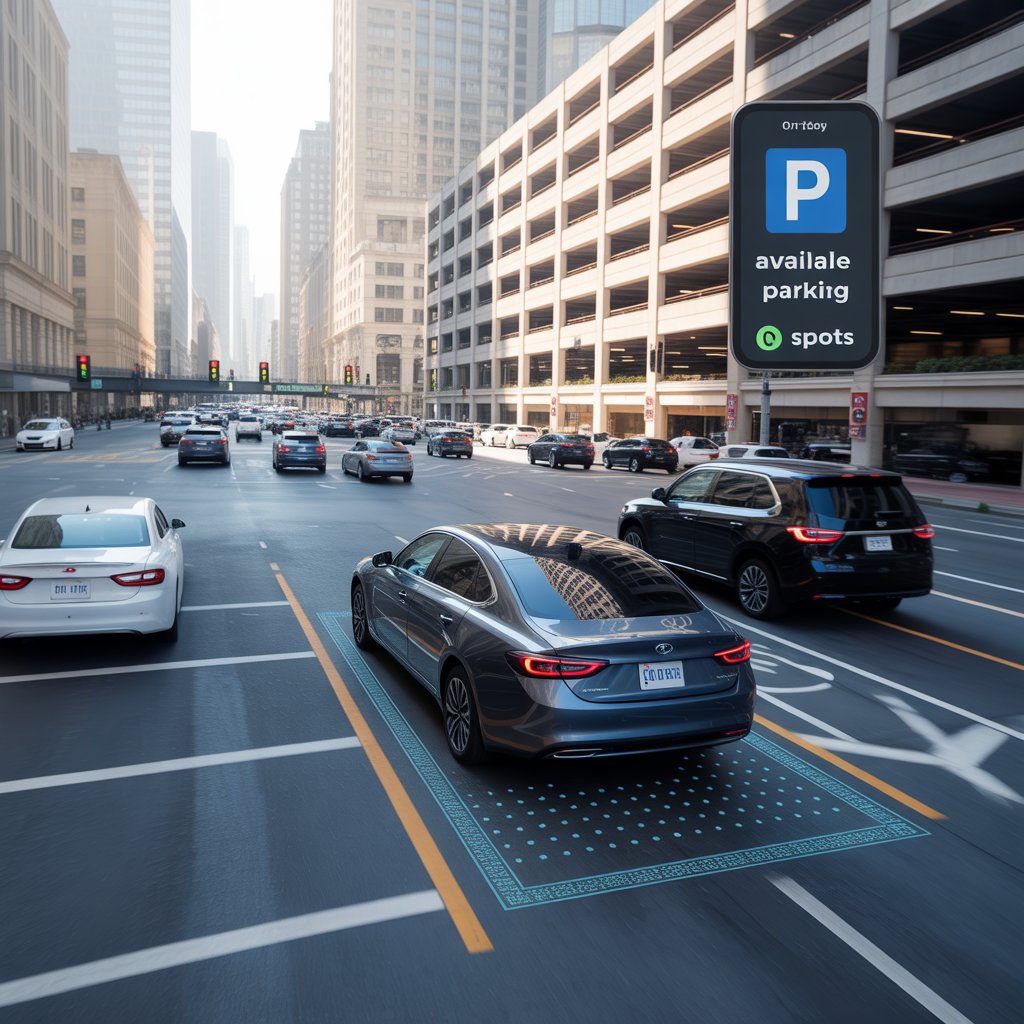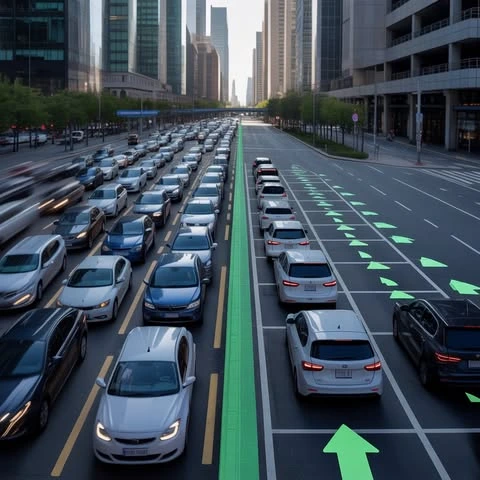Discover how smart parking systems and IoT parking solutions can reduce traffic congestion, save time, and transform urban mobility in India.

Every driver in India knows the struggle to hunt for a parking lot in a crowded city. Whether it is Mumbai, Delhi or Bangalore, finding a free place looks like a lottery. Studies show that up to 30% of urban congestion traffic, including discovering parking, comes from mandated vehicles in circles.
More than 20 million vehicles are added every year, and Indian cities are suffocating under growing traffic, irregular on-street parking, and reduced land availability. The solution is not always in the manufacture of more roads – sometimes, it is about using technology cleverly.
Where smart parking solutions come, in combination with IOT sensors, automation, mobile apps, and data analytics, these systems are changing how vehicles are parked and managed – and in this process, cutting the crowd, pollution, and stress.

1. What are smart parking systems?
The smart parking system is an integrated technique that finds, monitors, and operates parking spaces using digital devices. Instead of searching for a location, smart systems guide them to the space available directly in real time.
Main components:
Sensor: Detect empty or filled slots.
IoT Connectivity: Deliver live data to the Central Dashboard.
Mobile Apps: Let users check availability or reserve space in advance.
Automated parking systems: Stack or puzzle systems maximize land utilization.
Digital payments: RFID tags, ANPR, or UPI, for instance, contactless transactions.
Together, these components make parking faster, safer, and more efficient, directly reducing unnecessary road traffic.

Traffic congestion isn’t just about too many vehicles – it’s about inefficiencies. A large portion of urban congestion comes from “search traffic” – cars circling blocks, waiting, or double-parking.
Drivers in dense areas spend an average of 10–15 minutes just finding parking, wasting fuel, and blocking others. This leads to:
In short, one of the invisible criminals behind a city-wide crowd is inappropriate parking management. Smart systems pursue this problem.0

IOT sensors detect empty locations and display availability on digital boards or mobile apps. The drivers can navigate directly to the nearest slot.
Effect:
Cruises reduce time by 30%
The road frees the streets used for the first search.
Smart parking apps allow users to reserve slots before arrival – similar to movie seat booking. In busy places such as malls, offices, or airports, it saves heavy time.
Effect:
No queue or inactivity
Less chaos during peak hours
Where the land is limited, automated or mechanical systems – such as stacks or tower parking – allow 2x -5x more vehicles on the same footprint.
Effect:
Roads end parking
Valuable road space is free.
Keeps vehicles organized and safe
Smart parking can charge variable rates based on demand, higher during rush hours and lower in off-peak times. This encourages even distribution and discourages long parking periods.
Effect:
Reduces congestion
The vehicle improves rotation and availability.
With RFID tags, ANPR (automated number plate identification), or QR-based gates, vehicles easily go inside and out without any manual delay.
Effect:
Fast turnover
Fewer crowds at the parking gates
The collected data reflects peak hours, high-demand areas, and occupancy rates. Municipalities can use it to design better parking layouts and traffic systems.
Effect:
Smart city scheme
Efficient use of public land and resources
Cities of India were never designed for today’s vehicle density. Roads are narrow, spaces are limited, and there are irregular parking clogs in each corner.
A traditional parking model can’t just keep the bus – with the cost of especially increasing urban population and real estate.
| Problem | Smart Parking Solution |
|---|---|
| Shortage of land | Vertical mechanical parking systems maximize space |
| Unregulated roadside parking | Sensor-based enforcement & digital management |
| Lack of parking data | IoT and analytics help predict demand |
| Long queues at entry | Automated access reduces waiting time |
| High pollution levels | Reduced idling lowers CO₂ and fuel waste |
Delhi introduced sensor-based parking and a mobile app that shows the availability of real-time slots in KNN AUGHT TT Place and other busy areas. The result: the search time is reduced, easier traffic flow, and better adherence.
Due to the lack of space for land, Mumbai developers and housing societies are adopting mechanical parking systems that triple their parking capacity. Companies like Elevate Parking provide custom-engineered solutions to maximize the efficiency of the space.
Pilot projects in Pune and Bangalore use IoT-enabled smart flour with integrated UPI payments. Drivers can find, book, and pay off all within one app.
These examples show how innovation can facilitate urban chaos when improving convenience and air quality.
A) environmental stability
Low vehicles inactive = less fuel burned.
Cities adopting smart parking have reported significant drops in CO₂ emissions and noise pollution.
B) economic efficiency
Automatic systems reduce the need for manual staff and paper. High space turnover also increases parking revenue for operators.
C) user facility
Application-based systems make parking easy, with easy no-cash payment, without confusion or frustration. A simple experience keeps customers loyal.
D) Improved Urban Design
-N-street parking means that more space for footpaths, green zones, and cycling tracks leads to more remainder and beautiful cities.
Despite the advantages, India faces real challenges:
Initial installation price: IoT devices and automation require additional investment.
Integration with existing infrastructure: Many old facilities lack digital preparation.
Maintenance: Sensors and elevators require periodic service for reliability.
Public awareness: drivers must be educated by using intelligent applications and follow-up of digital systems.
Politics and regulation: government institutions must standardize data exchange and dynamic prices.
These obstacles can be overcome with strong public-private cooperation and awareness campaigns.
As the Mission of the Smart City of India expands, parking will be an important focus of modernization. This is what they can bring in the next decades:
BOARDS BASED ON IA: parking systems that predict demand in real time.
Integration of electric vehicles: parking spaces with cargo stations for integrated electric vehicles.
Unified applications: Citivide applications that combine navigation, parking, and payment.
Green Parking: Ecological and Solar Energy Design.
Infrastructure prepared autonomously: intelligent flour equipped for autonomous vehicles.
The future of parking is not only digital: it is durable, it is based on data, and it is centered on the user.
Residential society in Thane faced daily crowds as only 30 parking slots were shared among 60 flats. Cars were often parked on the roads, blocking traffic.
Solution: Elevate Parking installed a two-level mechanical stack system, doubling the capacity of 60+ cars without expanding the soil area.
Result:
Traffic congestion in Indian cities is not just a feature of more cars – it is the result of older parking methods. By accepting smart parking systems, cities can make transportation easier, cleaner, and more efficient.
From real-time availability and dynamic prices and data analytics to Automation, these systems provide over every inch of parking in Optim while reducing fuel waste, emissions, and stress.
For developers, housing societies and municipalities, investing in smart parking is not just a structural reform – it is a step towards smart, green and more living.
In elevate parking, we create and produce customized mechanical and smart parking systems for residential, commercial and public spaces. Our advanced stack, puzzle and tower solutions help the maximum and well -organized operation.
🚗 Let’s transform parking – and reduce congestion, one project at a time.
📞 Contact Us: https://elevateparking.co.in/contact-us
A smart parking system uses IOT sensor, automation and mobile apps to detect available parking locations and find drivers in real time, reduce the search time and crowd.
By providing real-time availability, reservations, automated parking and dynamic pricing, smart parking systems reduce cruising times, prevent illegal roadside parking and improve overall traffic flow.
Yes. Indian cities face high vehicle density and limited land. Smart parking solutions such as mechanical stack parking and IoT-based monitoring are ideal for optimizing space and reducing congestion in urban areas.
Common technologies include:
IoT sensor to detect occupancy
ANPR/RFID for automated entry and payments
mobile apps for reservation
Mechanical lift/stack parking for space optimization
Yes. Modern systems can integrate EV charging stations into parking lots, allowing simultaneous parking and charging.
Cost varies depending on technology, automation level and capacity. Mechanical parking systems require high initial investment but provide long-term efficiency, space optimization and ROI.